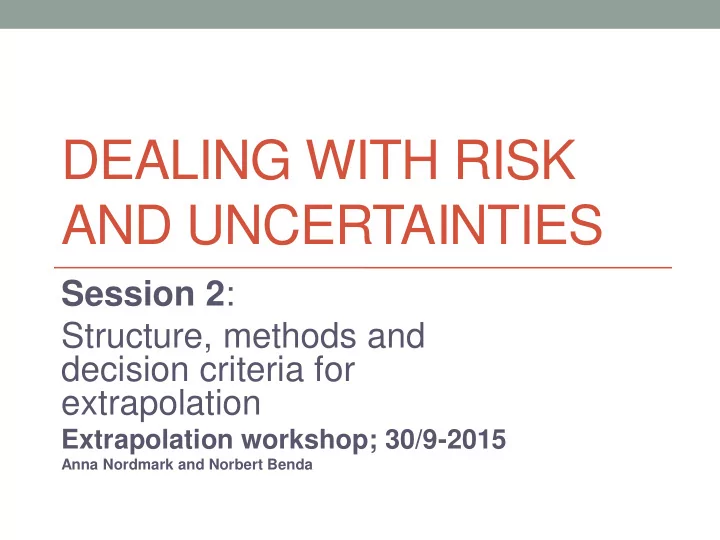

DEALING WITH RISK AND UNCERTAINTIES Session 2 : Structure, methods and decision criteria for extrapolation Extrapolation workshop; 30/9-2015 Anna Nordmark and Norbert Benda
Uncertainty in M&S used for extrapolation At which levels in M&S can uncertainty occur? • Input data • Physiological data • Structural model • Parameter estimates, statistical models • Assumptions (ADME, PD etc.) • Co-correlations • …… Outcome from the model
Assumptions Adult PK and PD data SOURCE DATA Modelling & Simulation OUTCOME: dose for pediatric trial Statistical model STRUCTURAL MODEL UNCERTAINTY UNCERTAINTY
Learn and confirm paradigm in M&S Assumptions Adult PK and PD data SOURCE DATA Modelling & Simulation Dose for pediatric trial Statistical model STRUCTURAL MODEL UNCERTAINTY UNCERTAINTY
Can M&S help in addressing uncertainty? • Quantify impact of input, parameter and assumption uncertainty in the resulting predictions • Address worst case scenarios or what-if scenarios (= Risk assessment) • To assess the consistency, robustness and distribution of the source data • To quantify the impact of uncertainty in input data and the extrapolation assumptions on predictions • Iterative loops of learn, plan and confirm to investigate and (in)validate assumptions in the extrapolation concept
Controlling of uncertainty in M&S? Important to remember that modelling is an iterative process of learning and confirming during the development process • Uncertain assumptions or parameters can be confirmed • Use of alternative sources of information to support assumptions or other vice reduce uncertainty (system data, other drug developments…) • To integrate pharmacological, clinical and statistical expert judgment to identify uncertainty and associated risks • To quantify the impact of uncertainty ( UQ ) in input data and the extrapolation assumptions on predictions
Decision making • Model predictions appropriately evaluated should inform decision making • Different levels of uncertainty in predictions may be acceptable depending on the type of risk and whether or not they can be mitigated • Expert judgement needed for decision making, need tools to support the uncertainty risk assessment of predictions
Uncertainty of the method • extrapolation exercise to generate a decision • drug /dose effective in children ? • estimation of treatment effect size, dose response, etc. • extrapolation stragegy may lead to wrong decisions • how often do you get a wrong decision ? • how precise would you estimate what you wish to estimate ? • extrapolation strategy more complex than a simple • statistical test • estimation function • evaluation of the extrapolation strategy by • simulating data under different assumptions • application of the extrapolation strategy to the different simulations • challenging evaluation task to quantify method uncertainty would be required
Example of an extrapolation strategy adult data Model based meta-analysis • PK/PD data on clinical outcome • efficacy data: trials 1,…, n • clinical outcome PK/PD modelling • PD additional assumptions / priors, e.g. (few) paediatric data • link adults – children • prior believe in efficacy • PK data • PK/PD data Conclusions for children • effect size assumptions on paediatric population • relation to covariates • covariate distribution • dose dependence baseline, gender, age, etc. • success probability for future paediatric studies
Evaluate extrapolation method Set of different extrapolation strategies Extrapolation Extrapolation Assumption set on strategy 1 strategy k • adult data • paediatric data • link Clinical Scenario Evaluation (CSE) Assumption 1 Repeated simulations of an extrapolation Assumption 2 exercise: • Simulation of adult trials and paediatric data according to the different assumptions • Apply different extrapolation strategies • Conclusion/result for a specific simulation Assumption r Summarize simulation results, e.g. • probability of a false positive decision cse framework described in = conclusion of a positive/relevant effect in children Benda et al (2010) Aspects of modernizing drug development … DIJ 44 if assumption x implies no effect in children Friede et al (2010) Refinement of the clinical scenario evaluation framework … DIJ 44
Questions for discussion • How to ensure implementation of M&S? • How to systematically ensure communication between groups of expertice to identify sources of uncertainty? • How to implement systematic use of Uncertainty Quantification and global sensitivity analyses? • What are optimal methodology for Uncertainty Quantification for various models? • What are good methods for supporting the expert decision making based on uncertainty risk assessment? • How to quantify the performance of extrapolation strategies? • Other aspects to improve the handling of uncertainty/risk?
Recommend
More recommend